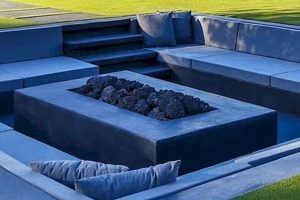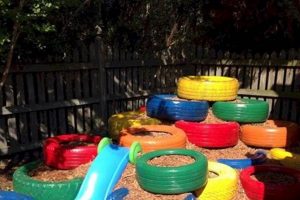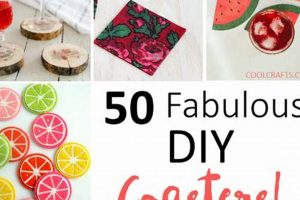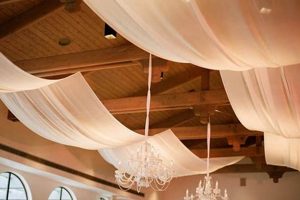Creating functional and aesthetically pleasing entry spaces on a budget frequently involves exploring do-it-yourself options for mudrooms. These projects range from simple organizational solutions to more complex renovations, all aimed at enhancing a home’s entryway. An example is building custom shelving from reclaimed lumber to maximize storage in a small area.
Developing a mudroom space through self-directed projects offers several advantages, including cost savings, personalization, and increased property value. Historically, dedicated entry spaces have evolved to meet changing needs, shifting from basic utility areas to more integrated and stylish elements of the home. DIY approaches allow homeowners to tailor these spaces precisely to their lifestyles and available square footage.
The following sections will delve into practical and resourceful methods for constructing or improving entry spaces. The discussions will encompass various design considerations, material choices, and project planning steps, all with the goal of achieving an efficient and attractive result.
Guidance for Affordable Entryway Organization
The following recommendations provide practical advice for executing cost-effective entryway improvements. Adherence to these guidelines can enhance the functionality and aesthetic appeal of the space.
Tip 1: Prioritize Vertical Space. Utilize wall-mounted shelving and hooks to maximize storage capacity in limited areas. Examples include installing floating shelves above benches or using tiered wall organizers for shoes and accessories.
Tip 2: Repurpose Existing Furniture. Consider adapting older furniture pieces into functional elements within the entryway. A repurposed dresser can serve as a bench with integrated storage, or an old bookcase can be converted into a shoe rack.
Tip 3: Implement Strategic Lighting. Adequate lighting is essential for both safety and aesthetics. Install energy-efficient lighting fixtures, such as LED strip lights under shelves or above benches, to illuminate the area effectively.
Tip 4: Utilize Durable and Budget-Friendly Materials. Select resilient materials that offer long-term value without significant expense. Concrete pavers or reclaimed wood can be used for flooring or accent walls, providing both durability and visual appeal.
Tip 5: Designate Zones for Specific Items. Establish dedicated areas for coats, shoes, bags, and other accessories. This can be achieved through the use of labeled bins, baskets, or custom-built dividers.
Tip 6: Maximize Natural Light. Enhance the entry area by optimizing the use of natural light. Ensure windows are unobstructed and consider adding a mirror to reflect and amplify available light sources.
Tip 7: Embrace Simple and Functional Design. Focus on creating a clean and uncluttered aesthetic. Avoid unnecessary embellishments and prioritize practical solutions that address specific organizational needs.
Tip 8: Focus on one project at a time. Completing a large project all at once can be daunting and expensive. Break the projects into smaller phases, spreading the expenses and making the work manageable.
Following these recommendations ensures a practical and visually appealing entryway, created through diligent planning and resourcefulness.
The subsequent sections will explore detailed case studies and specific project examples to illustrate the application of these guidelines.
1. Budget Allocation
Effective budget allocation is paramount to the success of any do-it-yourself mudroom project. Financial constraints invariably influence the scope and quality of improvements, necessitating careful planning and prioritization. Without a well-defined budget, projects can easily become unsustainable, resulting in incomplete or unsatisfactory outcomes.
- Material Cost Management
This facet involves identifying and sourcing cost-effective materials without compromising durability and aesthetics. For example, opting for reclaimed lumber or affordable alternatives to high-end flooring can significantly reduce overall expenses. Efficient material cost management ensures that the available funds are used judiciously, maximizing the project’s value within the allocated budget.
- Labor Cost Considerations
Do-it-yourself projects inherently eliminate professional labor costs, but they may require an investment in tools and equipment. The budget must account for the purchase or rental of necessary tools, as well as potential costs associated with acquiring specialized skills or knowledge. Accurate estimation of these hidden labor-related costs is crucial for effective budget allocation.
- Contingency Planning for Unexpected Expenses
Unforeseen issues, such as structural repairs or material shortages, can arise during the course of a DIY project. Allocating a contingency fund within the budget allows for addressing these unexpected expenses without derailing the entire project. A well-structured contingency plan provides financial flexibility and safeguards against potential disruptions.
- Prioritization of Essential Features
Budget constraints often necessitate prioritizing essential features over purely aesthetic enhancements. Focusing on core functionalities, such as efficient storage and durable flooring, ensures that the mudroom meets its primary purpose effectively. Prioritizing essential features allows for creating a functional and practical space, even within a limited budget.
Ultimately, strategic budget allocation dictates the feasibility and outcome of do-it-yourself mudroom enhancements. It influences the selection of materials, the scope of improvements, and the overall success of the project. By carefully managing resources and prioritizing essential features, homeowners can create functional and aesthetically pleasing entry spaces, even with limited financial means.
2. Space Optimization
Effective utilization of available area is a fundamental principle in the creation of functional and aesthetically pleasing entry spaces. In the context of do-it-yourself mudroom projects, space optimization becomes particularly critical due to constraints in square footage and the need to accommodate multiple functions within a limited footprint.
- Vertical Storage Solutions
Exploiting vertical space offers a strategic approach to maximizing storage capacity in compact entry areas. This involves utilizing wall-mounted shelving, hooks, and vertical organizers to store items such as coats, bags, and shoes. By extending storage solutions upwards, ground-level clutter is minimized, enhancing the perceived spaciousness of the mudroom. Examples include custom-built shelving units that
extend to the ceiling or tiered wall-mounted shoe racks. - Multipurpose Furniture Integration
Incorporating furniture items that serve multiple functions is an efficient method for optimizing space within entry areas. Benches with integrated storage compartments provide seating while also concealing shoes, gloves, and other accessories. Similarly, coat racks with built-in shelving offer dual functionality, serving as both hanging space and storage platforms. The strategic integration of multipurpose furniture maximizes utility while minimizing the need for separate, space-consuming items.
- Clever Organizational Accessories
The implementation of organizational accessories, such as baskets, bins, and dividers, facilitates efficient space management within mudroom environments. These accessories enable the compartmentalization of items, preventing clutter and promoting a sense of order. Labeled bins can be used to store seasonal items or individual family members’ belongings, while dividers within drawers or shelves allow for the organized storage of smaller accessories. The selection and strategic placement of organizational accessories enhance the usability and efficiency of the mudroom.
- Strategic Layout Design
Careful consideration of the mudroom layout contributes significantly to optimizing available space. Arranging furniture and storage solutions in a manner that promotes unobstructed movement and efficient traffic flow is crucial. Avoiding unnecessary obstacles and ensuring ample clearance between items prevents congestion and enhances the functionality of the space. A well-designed layout maximizes the utility of the mudroom by facilitating seamless interaction and ease of use.
These facets of space optimization are integral to the successful execution of do-it-yourself mudroom projects. By employing vertical storage solutions, integrating multipurpose furniture, utilizing organizational accessories, and strategically designing the layout, homeowners can transform compact entry spaces into functional and aesthetically pleasing areas. The focus on space optimization enhances the usability of the mudroom, making it a practical and inviting transition zone between the indoors and outdoors.
3. Material Selection
The success of do-it-yourself mudroom projects hinges significantly on informed material selection. Choices made regarding materials directly impact the durability, aesthetic appeal, and long-term maintenance requirements of the space. For instance, selecting moisture-resistant flooring like sealed concrete or durable tile is crucial in climates with frequent precipitation. Conversely, opting for untreated wood flooring in such environments can lead to water damage and premature deterioration, rendering the investment unsustainable. Therefore, material selection acts as a foundational element, influencing the longevity and functionality of the entryway.
Practical application of astute material selection involves a thorough assessment of the specific demands of the mudroom. In high-traffic areas, robust, scratch-resistant surfaces like porcelain tile or epoxy-coated concrete are preferable. For wall surfaces susceptible to scuff marks, washable paints or wainscoting provide both protection and ease of cleaning. An example includes families with pets choosing durable, easy-to-clean surfaces such as luxury vinyl plank, which withstands scratches and moisture better than hardwood. Understanding the causal relationship between material properties and environmental factors is key to ensuring the mudroom withstands daily use and maintains its aesthetic integrity.
In conclusion, material selection plays a critical role in determining the success of DIY mudroom renovations. Understanding material properties, environmental factors, and anticipated use patterns is essential for making informed decisions. While aesthetics are important, prioritizing durability and functionality ensures long-term cost-effectiveness and satisfaction with the project. The right selection of materials can transform an ordinary entryway into a functional and resilient space, capable of withstanding the rigors of daily use.
4. Storage Solutions
Effective storage solutions represent a cornerstone of successful mudroom implementations. The functionality of an entryway hinges on its capacity to manage and organize items entering and exiting the home. Disorganized entryways become sources of clutter and inefficiency, negating the intended purpose of this transitional space. A carefully planned storage system mitigates these issues and transforms the mudroom into a practical, orderly area. The absence of adequate storage inevitably leads to a disorganized space, undermining the very utility the project seeks to establish. A real-life example would be a mudroom without designated shoe storage quickly devolving into a tripping hazard and source of dirt tracking throughout the house.
The implementation of storage solutions in self-directed mudroom projects offers opportunities for customization and cost-effectiveness. Tailoring storage to meet specific needs, whether through custom-built shelving, repurposed furniture, or modular organizational systems, maximizes space utilization and accommodates individual preferences. For instance, a family with young children might prioritize low, accessible shelves for shoes and bags, while a household with frequent outdoor activities might opt for larger, more robust storage for sporting equipment. This level of personalization is often unattainable with pre-fabricated solutions, thereby enhancing the practicality and efficiency of the DIY approach. Proper space measurements and needs analysis are crucial to determining the correct type and size of storage components.
In summary, storage solutions are integral to the realization of functional and organized entry spaces through do-it-yourself projects. Effective storage transforms mudrooms from potential clutter zones into highly practical transition areas, supporting everyday routines. Understanding the connection between well-designed storage and the overall success of a mudroom project enables individuals to create tailored, cost-effective solutions that enhance both the aesthetic and functional aspects of the home. Neglecting this key element inevitably results in a compromised outcome, highlighting the necessity of prioritizing storage within any DIY mudroom endeavor.
5. Durability Focus
In the context of do-it-yourself mudroom projects, prioritizing durability is not merely a design consideration but a functional imperative. The mudroom, by its very nature, endures constant exposure to moisture, dirt, and abrasion, making it susceptible to rapid deterioration if not designed with resilience in mind. Therefore, a “Durability Focus” significantly influences the materials, construction methods, and design choices employed in self-directed entryway enhancements.
- Material Selection for Longevity
The selection of materials with inherent durability characteristics is critical. Flooring materials, for instance, should be resistant to water damage, scratching, and impact. Options such as porcela
in tile, sealed concrete, or durable vinyl plank offer superior resistance to the wear and tear associated with daily use. Similarly, wall surfaces should be finished with washable paints or protective coverings like wainscoting to prevent staining and damage from scuff marks. Failing to consider material longevity can lead to costly repairs or replacements, undermining the initial cost savings of a DIY approach. - Construction Techniques for Enhanced Stability
Employing robust construction techniques is essential for ensuring the structural integrity of DIY mudroom components. When building shelving or storage units, using solid wood or durable plywood, coupled with secure fastening methods, enhances stability and weight-bearing capacity. Proper sealing of joints and edges prevents moisture penetration, mitigating the risk of rot and decay. These construction practices extend the lifespan of the mudroom, reducing the need for frequent maintenance and repairs. Using proper waterproofing methods is as important in the mudroom as it is in a bathroom.
- Design Considerations for Wear Resistance
Design choices should also reflect a commitment to durability. For example, incorporating features such as built-in benches with sturdy frames and durable upholstery materials enhances the longevity and functionality of seating areas. Opting for hardware with corrosion-resistant finishes, such as stainless steel or powder-coated metal, prevents rust and maintains aesthetic appeal over time. Moreover, incorporating design elements that facilitate easy cleaning and maintenance, such as smooth surfaces and accessible storage compartments, minimizes the accumulation of dirt and grime, preserving the overall condition of the mudroom.
- Protection Against Environmental Factors
Addressing potential environmental stressors is crucial for ensuring the long-term durability of DIY mudroom projects. Implementing measures to mitigate moisture intrusion, such as proper ventilation and effective weather stripping, prevents water damage and mold growth. Protecting surfaces from excessive sunlight exposure with UV-resistant coatings or window treatments minimizes fading and deterioration. These proactive measures safeguard the mudroom against environmental factors, extending its lifespan and preserving its aesthetic appeal.
Ultimately, a “Durability Focus” is indispensable for achieving lasting success in do-it-yourself mudroom endeavors. By prioritizing material selection, construction techniques, design considerations, and environmental protection, homeowners can create entry spaces that not only meet their functional needs but also withstand the rigors of daily use for years to come. Neglecting durability in the initial stages of planning and execution will almost certainly lead to premature failure and increased long-term costs, underscoring the importance of incorporating this principle into every aspect of the project.
6. Personalization
Within the sphere of do-it-yourself mudroom projects, personalization extends beyond mere aesthetic preference; it becomes a functional adaptation reflecting the unique requirements of a household. The connection between individual needs and tailored design drives the inherent value of self-directed improvements. For example, a family engaged in multiple outdoor activities may require specialized storage for sporting equipment, while a household with elderly members benefits from incorporating accessible seating and non-slip flooring. This adaptation, rooted in personalized design, directly influences the utility and safety of the space.
The influence of personalization manifests in various practical applications. Utilizing repurposed materials, homeowners can create custom storage solutions that align with their specific belongings. Custom-built shelving, designed to accommodate specific dimensions, maximizes available space and enhances organizational efficiency. The aesthetic aspect of personalization often involves incorporating design elements that complement existing dcor, creating a cohesive and inviting atmosphere. An example of customization can extend to material choice as well. One individual may require low VOC paints due to an allergy, whereas this concern is not relevant to all. These details will create a safer and ultimately more usable mudroom for that homeowner and their family.
In conclusion, personalization represents a critical component of effective mudroom design, driving the development of functional and aesthetically pleasing entryways. By aligning design choices with individual needs and preferences, homeowners can transform basic spaces into efficient and welcoming transitional zones. While challenges may arise in executing personalized design elements, the resulting improvements significantly enhance the usability and value of the mudroom, emphasizing the importance of this element within do-it-yourself projects.
Frequently Asked Questions
This section addresses common inquiries concerning the planning, execution, and maintenance of self-directed mudroom improvements.
Question 1: What essential tools are required for most DIY mudroom projects?
A basic toolkit should include a measuring tape, level, drill, saw (circular or hand saw), screwdriver set, hammer, and safety glasses. More advanced projects may necessitate specialized tools such as a miter saw or nail gun.
Question 2: How can budget constraints be effectively managed in DIY mudroom renovations?
Prioritize essential features over purely aesthetic enhancements. Source materials from salvage yards or online marketplaces to reduce costs. Repurpose existing furniture and fixtures wherever possible. Consider completing projects in phases to spread out expenses.
Question 3: What are the most durable flooring options for a high-traffic mudroom?
Porcelain tile, sealed concrete, and durable vinyl plank offer excellent resistance to water damage, scratching, and impact. Consider textured surfaces to enhance slip resistance.
Question 4: How can vertical space be maximized in a small mudroom?
Install wall-mounted shelving units, hooks, and vertical organizers. Utilize tall, narrow storage units to minimize floor space consumption. Build custom shelving to fit specific dimensions and storage needs.
Question 5: What are the best practices for preventing moisture damage in a mudroom?
Ensure adequate ventilation. Seal joints and edges with waterproof caulk. Use moisture-resistant materials for flooring, walls, and storage units. Implement a durable entryway mat to trap water and debris.
Question 6: How can a DIY mudroom be personalized to meet specific family needs?
Incorporate custom storage solutions tailored to individual belongings. Integrate seating areas with built-in storage compartments. Add design elements that reflect personal style and complement existing dcor.
Effective do-it-yourself mudroom transformations hinges on thorough preparation, careful execution, and attention to detail. By addressing these common queries, individuals can mitigate potential challenges and ensure a successful project.
The subsequent section will summarize key takeaways and offer closing advice to aid in the development of functional and aesthetically pleasing entry spaces.
Conclusion
The preceding discussion has presented a comprehensive overview of “mudroom ideas diy,” emphasizing essential considerations for planni
ng and executing self-directed projects. Material selection, space optimization, and budget allocation stand out as critical factors influencing project success. Proper execution of these elements facilitates the creation of functional and aesthetically appealing entry spaces tailored to individual needs.
Successful implementation of “mudroom ideas diy” demands diligent planning and thoughtful execution. The insights presented are intended to empower individuals to enhance their living spaces effectively and affordably. Careful consideration of the presented principles offers a pathway toward transforming mundane entryways into functional and welcoming areas.







